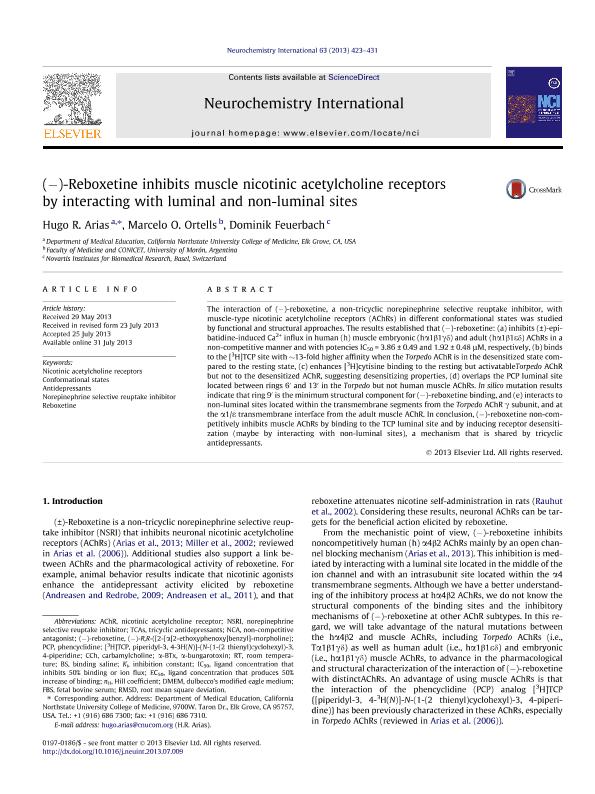Artículo
(−)-Reboxetine inhibits muscle nicotinic acetylcholine receptors by interacting with luminal and non-luminal sites
Fecha de publicación:
07/2013
Editorial:
Elsevier
Revista:
Neurochemistry International
ISSN:
0197-0186
Idioma:
Inglés
Tipo de recurso:
Artículo publicado
Clasificación temática:
Resumen
The interaction of (−)-reboxetine, a non-tricyclic norepinephrine selective reuptake inhibitor, with muscle-type nicotinic acetylcholine receptors (AChRs) in different conformational states was studied by functional and structural approaches. The results established that (−)-reboxetine: (a) inhibits (±)-epibatidine-induced Ca2+ influx in human (h) muscle embryonic (hα1β1γδ) and adult (hα1β1εδ) AChRs in a non-competitive manner and with potencies IC50 = 3.86 ± 0.49 and 1.92 ± 0.48 μM, respectively, (b) binds to the [3H]TCP site with ∼13-fold higher affinity when the Torpedo AChR is in the desensitized state compared to the resting state, (c) enhances [3H]cytisine binding to the resting but activatableTorpedo AChR but not to the desensitized AChR, suggesting desensitizing properties, (d) overlaps the PCP luminal site located between rings 6′ and 13′ in the Torpedo but not human muscle AChRs. In silico mutation results indicate that ring 9′ is the minimum structural component for (−)-reboxetine binding, and (e) interacts to non-luminal sites located within the transmembrane segments from the Torpedo AChR γ subunit, and at the α1/ε transmembrane interface from the adult muscle AChR. In conclusion, (−)-reboxetine non-competitively inhibits muscle AChRs by binding to the TCP luminal site and by inducing receptor desensitization (maybe by interacting with non-luminal sites), a mechanism that is shared by tricyclic antidepressants.
Archivos asociados
Licencia
Identificadores
Colecciones
Articulos(SEDE CENTRAL)
Articulos de SEDE CENTRAL
Articulos de SEDE CENTRAL
Citación
Arias, Hugo Rubén; Ortells, Marcelo Oscar; Feuerbach, Dominik; (−)-Reboxetine inhibits muscle nicotinic acetylcholine receptors by interacting with luminal and non-luminal sites; Elsevier; Neurochemistry International; 63; 5; 7-2013; 423-431
Compartir
Altmétricas




